by Winding Pathways | Aug 22, 2019 | Chickens, Garden/Yard
We were delighted when our Lavender Orpington hen started acting strangely. She fluffed up her feathers, spent most of her time in a nest box, and gave us a stern warning call if we came too close. She was broody.
A broody hen simply wants to be a mother. Her ambition is to keep a clutch of eggs warm for 21 days and then raise a bunch of bouncy babies to chicken adolescence. We don’t have a rooster so all of our hen’s eggs are infertile and won’t hatch. Broody doesn’t know this, but we found a way to have her happily raise a brood of chicks.
After about two weeks of incubation, we bought a dozen chicks from a local farm store and slipped them under her after dark. Motherhood commenced.
Watching a mother hen is interesting but listening is truly fascinating. While on eggs she sat almost trancelike, but the peeping awakened her. She began clucking in a tone that must have both comforted the downy chicks and instructed them to get into the warmth and security of her feathers.
The next morning she used a different clucking tone to introduce the babes to the big world. They followed her out of the nest and scampered around the coop. We don’t speak “chicken” but she clucked again and it must have meant, “come over here and eat.” She put her beak in a feeder filled with chick starter. The bravest babies picked a few crumbs of feed off her beak and soon all were eating and dipping their beaks into a nearby waterer for a cool drink.
Mother hens are attentive and have a vocabulary of many “words” or at least different sounding clucks. When the babes got too far from her she’d cluck in a certain way bringing them scampering back to safety near or under Mom. If she scratched up a delicious tidbit she’d utter a different sounding cluck and the babies would rush over and enjoy a food new to them. She taught them safety and the fine art of foraging.
-
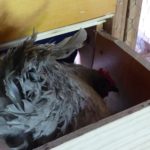
-
Lavender Orpington wants to be a mother!
-

-
A mama hen will sit contently on golf balls until new chicks arrive.
-
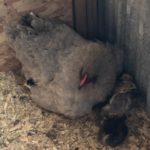
-
Babies gather round Mama Hen at night.
See these YouTube videos and photos of our most recent broody and foraging for treats.
Tucking in for the Night
Under Mama’s Watchful Eye
Babies Eating Corn
At the Gate Waiting for Treats
Treat Bucket
Feasting on Corn
by Marion Patterson | Mar 14, 2019 | (Sub)Urban Homesteading, Chickens, Garden/Yard
In the past few years, thousands of Americans have begun tending small flocks of chickens in their backyards. For most folks, it’s a new hobby, but we’ve been at it far longer. Rich began raising chickens in his suburban backyard when he was eight or nine years old – over 60 years ago. Marion’s family raised chickens at their New Hampshire home.
This spring many chicken newcomers will install a coop, raise chicks, and produce delicious food in their yards. It can be complicated, so this blog is designed to explain chicken husbandry in its very simplest form. Many books in most libraries and websites on chicken culture give detailed chicken care information and are outstanding resources. We recommend checking Hoover’s Hatchery. It offers a printed catalog, an online catalog, and website blogs. We also do a Facebook Live program each month for Hoover’s about different aspects of chicken care. Also see Scoop from the Coop for detailed information.
Chicks
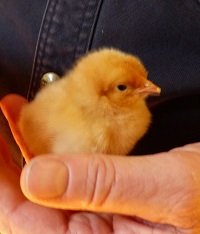
Baby chicks can be purchased on line.
Baby chicks can be purchased online. Most hatcheries require a minimum order of 15 or 25 babies, usually more than most families want. Smaller quantities can be purchased at farm stores, such as Tractor Supply. Many cities have ordinances allowing chickens but usually limit the flock size to six or fewer birds. Check your local ordinance before buying.
Chicks come in dozens of different breeds, but we suggest choosing those that lay brown eggs. These breeds are fairly large bodied, calm birds. Our long-term favorites are New Englanders like the Rhode Island or New Hampshire Reds, or the Barred Plymouth Rock. Other great breeds are Wyandottes, Orpingtons, and Australorps. White egg breeds, like Leghorns, lay like crazy but are more nervous and noisier than brown eggers.
Often, it’s possible to buy a variety of breeds. Having a six hen flock composed of six different breeds is colorful and fun.
Housing
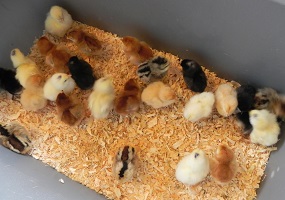
Chicks need to be warm until their insulating feather grow.
Baby chicks need to be warm until their insulating feathers grow. They are reared in a device called a brooder. A simple one can be made with items most people have around the house. See the blog on building a brooder on Hoover’s Hatchery Website for detail.
By the time the babies are six weeks, or so, old they need to move into permanent quarters, the chicken coop. The easiest way for a family to start is to buy a pre-made coop online or at a farm store. These range in size from tiny ones that will fit just a couple of hens to those that might fit up to a dozen. It’s a good idea to have an attached outside fenced in area, called a run, so the hens can enjoy fresh air and sunshine. Building a coop isn’t difficult and plans are printed in most basic chicken books or can be downloaded from websites.
Chicken houses need fluffy bedding, called litter, covering the floor. Pine chips work great. Bales of chips can be bought at farm stores. Every coop should have a nest for hens to lay their eggs in and a pole installed parallel to the floor for them to roost on. Yup, chickens sleep standing up.
The house should have windows that can be closed to prevent cold winter drafts but open to welcome fresh summer air. Cover windows with mosquito mesh and heavy wire to discourage both bugs and raccoons. Neighborhood raccoons would love a chicken dinner, so keep them out of the coop!
Food and Drink
Stores that sell baby chicks almost always sell feed. Babies need a high protein mash called Chick Starter from the time they hatch until they lay their first egg. Then switch to Layer feed. Simple inexpensive feeders are sold in farm stores. Chickens love drinking fresh water so invest in a water fount and keep it full. Hens enjoy a handful of corn every once in a while, as a treat. They also love table scraps. We give ours bits of rice, squash seeds and hulls, meat scraps and a few other things. As with all treats, we keep portions small.
The Nutshell
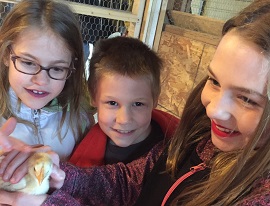
Raising chickens helps kids learn care and responsibility.
This is chicken husbandry in a nutshell. There’s lots more to it, so be sure to read websites and books on chicken care before buying your first batch of chicks. If you are lucky you can take a backyard chicken basic class at a nearby nature or garden center.
by Winding Pathways | Apr 19, 2018 | Chickens, Garden/Yard, Garden/Yard
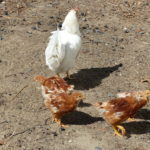
Mama Hen with chicks foraging.
Now a couple of months old, the quartet of chicks is exploring farther afield. After the cold and snowy introduction to the outside world in late March, they readily follow Mama Hen outside.
Mama protects them inside from the other hens by cornering the chicks and standing literally in front of them, screening them from the others who get too close. Outside, Mama clucks and calls the chicks over for food and again, warns off the adults with a serious sounding tone and lunge toward one that may get too close to the chicks or be aggressive toward them.
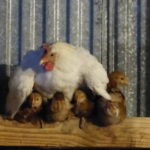
Mama hen with four chicks on roost.
The chicks learned how to fly up onto the roost with Mama and she mightily shelters them at night. We were worried the first few nights in April when temperatures fell to 11 degrees. But, they did OK.
Getting back down off the high perch is a challenge. A hilarious video shows three on the ground foraging and one walking back and forth screwing up courage for the long “flight” down.
The other day, one chick squeezed through the wire into the yard. Mama called it back. The funny thing about chickens is they can figure out how to get out and sometimes cannot figure out how to get back in.
Enjoy our blogs, pix and videos of the chicks growing up.
by Winding Pathways | Apr 1, 2018 | Chickens
We’ve had fun allowing the California White to brood and then raise four chicks we placed under her one night. She’s been an attentive Mama showing the chicks how to eat, accept new foods, and forage outside in the snow.
Each evening she tucks them into her feathers and keeps them warm.
Here are some pictures from March. Go to Winding Pathways You Tube for short videos of the Mama Hen and chicks.
-
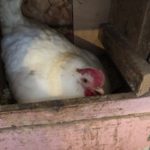
-
Sometimes hens go broody at the wrong time of year. February Was much too early.
-
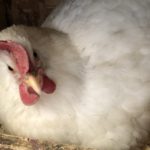
-
The California White patiently sitting.
-
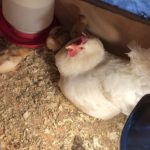
-
Mama California tucks the babies in for the night.
-

-
Chicks tentatively go outside for the first time.
by Winding Pathways | Mar 17, 2017 | Chickens
Baby Chicks Find a Home at Winding Pathways
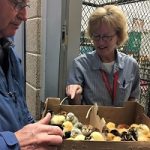
Enjoying the chicks
The call from our post office came at 6 a.m. “Could you please come soon and pick up a box of peeping baby chicks,” requested the pleasant postal worker. Soon we were in the car en-route to retrieve the babies. We were excited, but the story really began months earlier.
The Girls are Getting Old
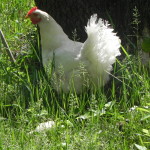
Going on their third lay cycle, the girls are getting old.
Our 13 hens were laying well but we knew they were on the downside of production. Young hens, called pullets, start laying when they are around 20 to 24 weeks old. During the approximately 14 months of their lay cycle we expect about 275 to 300 eggs per hen. Then they declare a vacation, take a break, shed their worn feathers, fatten up a bit, grow new feathers, increase their calcium, and after six or eight weeks begin their second lay cycle. They’ll produce fewer eggs this time and as they continue to age we can expect ever fewer eggs. So, about every third year we order baby chicks that grow into pullets to replace the old girls. The process takes time and requires planning.
Getting Ready for Baby Chicks
Around Christmas we began planning our new chick order. This year we cooperated with two friends. Each wanted some chicks but not a full order of 25. So, we placed a joint order with Hoover’s Hatchery in the tiny town of Rudd, Iowa. Leafing through their paper catalog and double checking their website helped us decide to order 50 chicks of diverse breeds. They’d collectively be a rainbow of feather colors and would lay light and dark brown, white, and blue/green eggs. We placed our order in January. Then, preparation really began.
Preparing for the Arrival
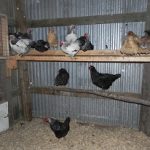
Keep adult chickens separate from chicks.
Our old chickens are in a coop Rich built in the corner of our small barn. We wanted to keep them until the new ones start laying in mid-summer. You don’t put baby chicks in with old ones. It just doesn’t work. Birds, like most creatures, are territorial and the old birds will kill the newcomers. The hens and chicks need to be kept apart. So, Rich made a second coop next to the existing one but separated by a wire and plywood wall. Inside the new coop, he made a large plywood box, complete with a plywood lid and two heat lamps to keep the babies warm until their feathers grew in and the weather warmed.
Hoover’s Hatchery sent a confirmation that the babies would arrive on March 15th. Gulp, the Ides of March. And, as it turned out, one of the colder days of winter.
Hoover’s also confirmed the breeds we ordered and the gender of each. We like having chicks arrive just as the winter is starting to wane and the weather is warming up. Normally our heat lamps keep the baby chicks warm in their brooder in the barn, but mother nature threw us a last-minute curve in 2017. A zero-degree low temperature was predicted. The lamps just couldn’t keep the birds warm enough in that chill, so just before arrival day Rich made two temporary brooders out of wooden boxes we had on hand. He set them up downstairs in the house in the same room as our wood stove. It’s the coziest room in the house. A couple of small lights in each wooden box was all that was needed to keep the chicks comfy in the heated room.
We hoped the arrangement would only last a few days until the weather warmed and the babies could move into the barn brooder. That many baby chicks start to smell after a few days. Everything was ready by the evening of March 13. The next two nights were frigid but the temporary brooders stayed warm.
-
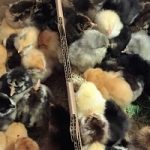
-
Chicks stay warmer crowded in a box for the journey.
-

-
A temporary shelter until temperatures moderate.
-

-
Warm packs keep the chicks warm during shipping.
Each of the small brooders had a quarter inch of wood chips on the floor and a simple plastic drinking water dispenser that we had bought at a local store. An egg carton served as a temporary feeder sturdy enough to last only a couple of days until we switched to metal feeders.
Why Baby Chicks Can Be Shipped in the Mail
Baby chicks have an amazing adaptation that allows hatcheries to ship them all over the world. While they develop as embryos inside the egg they draw nutrition from the yolk. After 21 days in Hoover’s Hatchery incubators the chicks emerge wet and gangly. But, much of the yolk remains inside them and provides plenty of nutrition for their first few days of life.
As soon as their wet fluff dries Hoover’s staff remove the tiny babies from the incubators, sorts them by gender and breed, and puts them in shipping boxes that soon go to the post office. Every week hundreds of boxes and thousands of chicks get sent every which way. They safely reach destinations as far away as Florida and Alaska. If it’s cold out, Hoover’s slips warming pads inside the box with the chicks. Because they are still living off their yolk the babies don’t need to eat or drink during their journey which is often by airplane.
Our chicks arrived at the Cedar Rapids Post office when just a day old and by the time we got them to the house they were but 26 hours old! All 52 chicks arrived safe and sound, and loudly peeping. We opened the box at the post office to make sure they were all alive and because the postal service workers really wanted to take a peek at them. Then we hustled home. Rich gently picked each baby up, dipped its bill into the waterer in the brooder so they knew where to drink, and released it. Soon the shipping box was empty and the two brooders full of peeping babies. They were thirsty, hungry, and sleepy and began pecking at their food, drinking water, and tumbling over to the floor for frequent naps.
-
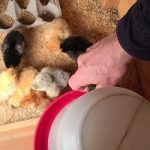
-
Chicks know how to forage, but have to be introduced to water.
-
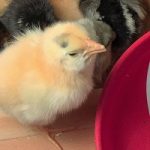
-
Only a day old, chicks learn to drink.
-

-
Day old chicks peck like pros at the nutritious feed.
Baby chicks are fun to watch. It’s a miracle of nature that an animal so young can feed itself and drink water without being tutored by a mother.
Baby Chick Nutrition
Adult chickens are omnivores that love seeds, worms, insects, fruit, and all sorts of other tidbits they find while scratching around outside. Baby chicks need a high protein diet and are too young to forage on their own, so we buy high protein feed called chick starter. It will be their main diet until they are old enough to forage in the run in a few months. Just before they start laying in about five months we’ll switch them to a layer feed that’s a little lower in protein but higher in calcium to meet the nutritional needs of a laying hen.
Making the Summer Switcheroo
As the chicks grow they’ll get too crowded in the brooder. By then spring will be in full glory and the weather warmer. Rich will take apart the brooder and let the adolescent birds roam around the full coop. They’ll grow fast and by early summer will need even more space. That will be time to say goodbye to the old hens and our one rooster. We put a notice on Craig’s list and have no problem selling the old birds for a buck apiece – a bargain for someone who wants older hens.
As soon as they are gone Rich will scoop the litter (a word that means the wood chips mixed with dry manure on the floor) and sprinkle it lightly on the garden. When used sparingly chicken manure is outstanding fertilizer that will stimulate the lettuce, chard, okra, tomatoes and squash that we harvest in summer. Then he’ll spray down the roosts, nests, feeders, walls and floor with a mild bleach/water solution and give it a day or two to dry. Next, are added a few inches of new clean wood chips to the floor and we welcome the youngsters to enjoy their new home.
This coop has a small door, called a pop hole, that leads outside to a huge fenced in run where the birds enjoy basking in the sun or sitting in the shade of a few small trees. They hunt for bugs and worms, exercise, and socialize outside or inside wherever they choose to be.
What Adult Chickens Need
Outfitting the coop for adult chickens is simple. Rich, being the consummate forager himself, made a feeder of scrap wood. Manufactured ones also work well. The birds always have a few buckets of drinking water and clean litter. A 2″X4″ with edges rounded off that spans the coop about four feet above the floor makes a comfortable roost, where the birds lounge during the day and sleep at night. It’s their bed. Can you imagine sleeping on your feet perched upright? Chickens do it every night. Many years ago, we salvaged a wooden nest that has eight nests, each about 12” by 12”. That’s where the chickens lay eggs. Our chickens always get fresh feed and water daily, and we harvest their eggs each afternoon.
Raccoons, opossums, skunks, mink, cats, and roving dogs all love to kill chickens, but mostly they prowl night. At dusk chickens always head inside and hop up to their roosts to sleep for the night. Rich or Marion closes and secure the latched pop hole door. Predators can’t reach the safely sleeping chickens. The chickens hop off the roost at dawn and greet the new day.
-

-
Sweet smile.
-

-
Newborn Orpington
-

-
Children learn care of chicks.
At Winding Pathways, we love our chickens. They eagerly gobble kitchen scraps that otherwise would end up in the compost bin or trash and return us the world’s best eggs. We learn plenty from watching our chickens. Children grow up understanding where food comes from and how to care for animals. Over the years, we’ve learned they are remarkably intelligent with a well-defined social structure. They also have an extensive vocabulary. The different sounds they make mean different things. When given plenty of space, great care, and good food, chickens are clean, pleasant, and fun to be around. We wouldn’t want to live without their company and delicious eggs.
























